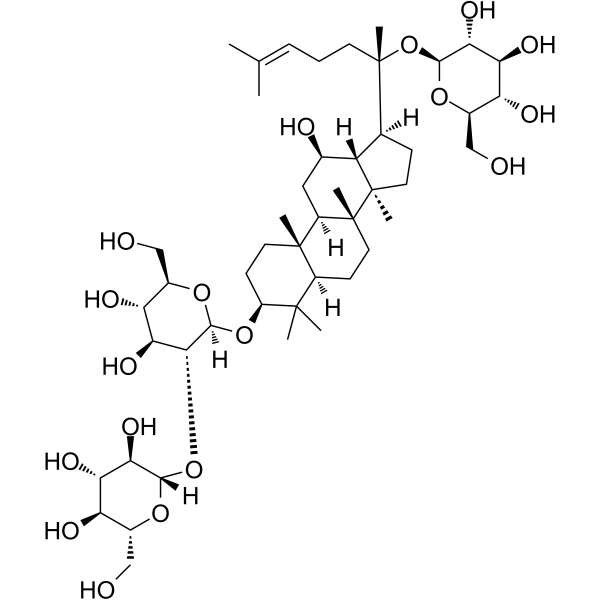天然产物 糖类和糖苷 Saccharides and Glycosides
Ginsenoside Rd;(Synonyms: 人参皂苷 Rd; Gypenoside VIII) 纯度: 98.02%
Ginsenoside Rd 抑制 TNFα 诱导的 NF-κB 转录活性,IC50 为 12.05±0.82 μM。Ginsenoside Rd 抑制 COX-2 和 iNOS mRNA 的表达。Ginsenoside Rd 还抑制 Ca2+ 内流。Ginsenoside Rd 抑制CYP2D6,CYP1A2,CYP3A4 和 CYP2C9,IC50 分别为 58.0±4.5 μM,78.4±5.3 μM,81.7±2.6 μM 和 85.1±9.1 μM。

Ginsenoside Rd Chemical Structure
CAS No. : 52705-93-8
| 规格 | 价格 | 是否有货 | 数量 |
|---|---|---|---|
| 10;mM;*;1 mL in DMSO | ¥1250 | In-stock | |
| 5 mg | ¥700 | In-stock | |
| 10 mg | ¥1200 | In-stock | |
| 50 mg | ; | 询价 | ; |
| 100 mg | ; | 询价 | ; |
* Please select Quantity before adding items.
Ginsenoside Rd 相关产品
bull;相关化合物库:
- Natural Product Library Plus
- Bioactive Compound Library Plus
- Immunology/Inflammation Compound Library
- Membrane Transporter/Ion Channel Compound Library
- Metabolism/Protease Compound Library
- Neuronal Signaling Compound Library
- NF-kappa;B Signaling Compound Library
- Stem Cell Signaling Compound Library
- Natural Product Library
- Anti-Cancer Compound Library
- Human Endogenous Metabolite Compound Library
- Anti-Aging Compound Library
- Antioxidants Compound Library
- Differentiation Inducing Compound Library
- Glycoside Compound Library
- Lipid Compound Library
- Oxygen Sensing Compound Library
- Anti-Cardiovascular Disease Compound Library
- Medicine Food Homology Compound Library
- Terpenoids Library
- Pyroptosis Compound Library
- Traditional Chinese Medicine Monomer Library
- Neuroprotective Compound Library
- Anti-Breast Cancer Compound Library
- Anti-Pancreatic Cancer Compound Library
- Anti-Blood Cancer Compound Library
- Anti-Obesity Compound Library
- Transcription Factor Targeted Library
- Food-Sourced Compound Library
- Anti-Liver Cancer Compound Library
- Anti-Colorectal Cancer Compound Library
| 生物活性 |
Ginsenoside Rd inhibits TNFα-induced NF-κB transcriptional activity with an IC50 of 12.05±0.82 μM in HepG2 cells. Ginsenoside Rd inhibits expression of COX-2 and iNOS mRNA. Ginsenoside Rd also inhibits Ca2+ influx. Ginsenoside Rd inhibits CYP2D6, CYP1A2, CYP3A4, and CYP2C9, with IC50s of 58.0±4.5 μM, 78.4±5.3 μM, 81.7±2.6 μM, and 85.1±9.1 μM, respectively. |
||||||||||||||||
|---|---|---|---|---|---|---|---|---|---|---|---|---|---|---|---|---|---|
| IC50 Target |
|
||||||||||||||||
| 体外研究 (In Vitro) |
Ginsenoside Rd is one of the most abundant ingredients of Panax ginseng. Ginsenoside Rd significantly inhibits TNF-α-induced NF-κB transcriptional activity with an IC50 of 12.05±0.82 in HepG2 cells. Ginsenoside Rd also inhibits expression of COX-2 and iNOS mRNA and iNOS promoter activity in a dose-dependent manner. To determine nontoxic concentrations, HepG2 cells are treated with various concentrations (0.1, 1, and 10 μM) of compounds (e.g., Ginsenoside Rd) and cell viability is measured using an MTS assay. No compounds are significantly cytotoxic at up to 10 μM, indicating that NF-κB inhibition is not due to cell toxicity[1]. Ginsenoside Rd is one of the most abundant ingredients of Panax ginseng, protects the heart via multiple mechanisms including the inhibition of Ca2+ influx. Ginsenoside Rd reduces ICa,L peak amplitude in a concentration-dependent manner (IC50=32.4±7.1 μM)[2]. Ginsenoside Rd exhibits an inhibition against the activity of CYP2D6 in human liver microsomes with an IC50 of 58.0±4.5 μM, a weak inhibition against the activity of CYP1A2, CYP3A4, and CYP2C9 in human liver microsomes with IC50s of 78.4±5.3, 81.7±2.6, and 85.1±9.1, respectively, and an even weaker inhibition against the activity of CYP2A6 in human liver microsomes with an IC50 value of more than 100 μM[4]. MCE has not independently confirmed the accuracy of these methods. They are for reference only. |
||||||||||||||||
| 体内研究 (In Vivo) |
Ginsenosides Rd is a major compound isolated from Gynostemma pentaphyllum that holistically improves gut microenvironment and induces anti-polyposis in ApcMin/+ mice. Six-weeks-old mice are subjected to Ginsenoside Rd treatment, before the appearance of the intestinal polyps. All the mice are monitored for food intake, water consumption, and weight changes. Throughout the experiment, no Rb3/ Ginsenoside Rd-associated weight loss in mice is observed. In addition, none of the treated mice show variations in food and water consumption. Whereas, the number and size of the polyps are effectively reduced by Ginsenoside Rd treatments[3]. MCE has not independently confirmed the accuracy of these methods. They are for reference only. |
||||||||||||||||
| 分子量 |
947.15 |
||||||||||||||||
| Formula |
C48H82O18 |
||||||||||||||||
| CAS 号 |
52705-93-8 |
||||||||||||||||
| 中文名称 |
人参皂苷 Rd |
||||||||||||||||
| 运输条件 |
Room temperature in continental US; may vary elsewhere. |
||||||||||||||||
| 储存方式 |
|
||||||||||||||||
| 溶解性数据 |
In Vitro:;
DMSO : 100 mg/mL (105.58 mM; Need ultrasonic) 配制储备液
*
请根据产品在不同溶剂中的溶解度选择合适的溶剂配制储备液;一旦配成溶液,请分装保存,避免反复冻融造成的产品失效。 In Vivo:
请根据您的实验动物和给药方式选择适当的溶解方案。以下溶解方案都请先按照 In Vitro 方式配制澄清的储备液,再依次添加助溶剂: ——为保证实验结果的可靠性,澄清的储备液可以根据储存条件,适当保存;体内实验的工作液,建议您现用现配,当天使用; 以下溶剂前显示的百
|
||||||||||||||||
| 参考文献 |
|
| Cell Assay [1] |
An MTS assay is used to analyze the effects of the compounds on cell viability. HepG2 cells are cultured overnight in a 96-well plate (1×104 cells/well). Cell viability is assessed after adding the compounds (e.g., Ginsenoside Rd; 0.1, 1, and 10 μM) for 24 h. The number of viable cells is determined by the A490nm of the dissolved formazan product, after addition of MTS for 30 min[1]. MCE has not independently confirmed the accuracy of these methods. They are for reference only. |
|---|---|
| Animal Administration [3] |
Mice[3] MCE has not independently confirmed the accuracy of these methods. They are for reference only. |
| 参考文献 |
|
